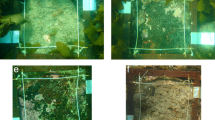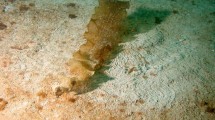Abstract
Kelp regeneration was observed for the first time in St. Margaret's Bay, Nova Scotia, Canada in an area known to have been devoid of macroalgae for several years. The regeneration was destroyed by sea urchins within 10 months. Experimentally induced kelp regeneration met a similar fate under normal grazing pressure. At the lowest sea urchin biomass and density encountered re-establishment of mature kelp stands seems highly unlikely. The sea urchin population required to suppress kelp regeneration is fed by benthic microalgae. Diatoms and other pioneer algal community species were found in the guts of sea urchins. The mean standing crop of benthic microalgae was found to be, 2.2 g C m-2 and production estimated as ca 15 g C m-2yr-1 at 8m depth. Most of the primary production of St. Margaret's Bay has been lost with the disappearing kelp populations.
Similar content being viewed by others
Literature Cited
Adey, W. H.: The effects of light and temperature on growth rates in boreal-subarctic crustose corallines. J. Phycol. 6, 269–276 (1970)
Anderson, E. K. and W. J. North: In situ studies of spore production and dispersal in the giant kelp Macrocystis. Proc. Int. Seaweed Symp. 5, 73–86 (1966)
Beers, C. D.: The obligate commensal ciliates of Strongylocentrotus droebachiensis: occurrence and division in urchins of diverse ages: survival in sea water in relation to infectivity. Biol. Bull. 121, 69–81 (1961)
Breen, P. A. and K. H. Mann: Destructive grazing of kelp by sea urchins in Eastern Canada. J. Fish. Res. Bd. Can. 33, 1278–1283 (1976)
Chapman, A.R.O.: Biology of seaweeds: levels of organization. xv+134 pp. Baltimore: University Park Press 1979
Chapman, S. B.: Production ecology and nutrient budgets. In: Methods in plant ecology, pp 157–228. Ed. by S. B. Chapman. Oxford: Blackwell, Scientific Publication 1976
Dayton, P. K.: Dispersion, dispersal and persistence of the annual intertidal alga Postelsia palmaeformis. Ruprecht. Ecology 54, 433–438 (1973)
Grasshoff, K.: Methods of seawater analysis. xv+317 pp. Weinheim, New York: Verlag Chemie 1976
Lang, C. and K. H. Mann: Changes in sea urchin populations after the destruction of kelp beds. Mar. Biol. 36, 321–326 (1976)
Mann, K. H.: Ecological energetics of the seaweed zone in a marine bay on the Atlantic coast of Canada. I. Zonation and biomass of the seaweeds. Mar. Biol. 12, 1–10 (1972a)
Mann, K. H.: Ecological energetics of the seaweed zone in a marine bay on the Atlantic coast of Canada. II. Productivity of the seaweeds. Mar. Biol. 14, 199–209 (1972b)
Mann, K. H.: Destruction of kelp-beds by sea urchins: a cyclical phenomenon or irreversible degradation. Helgölander. wiss. Meeresunters. 30, 455–467 (1977)
Author information
Authors and Affiliations
Additional information
Communicated by R. O. Fournier, Halifax
Rights and permissions
About this article
Cite this article
Chapman, A.R.O. Stability of sea urchin dominated barren grounds following destructive grazing of kelp in St. Margaret's Bay, Eastern Canada. Mar. Biol. 62, 307–311 (1981). https://doi.org/10.1007/BF00397697
Accepted:
Issue Date:
DOI: https://doi.org/10.1007/BF00397697




